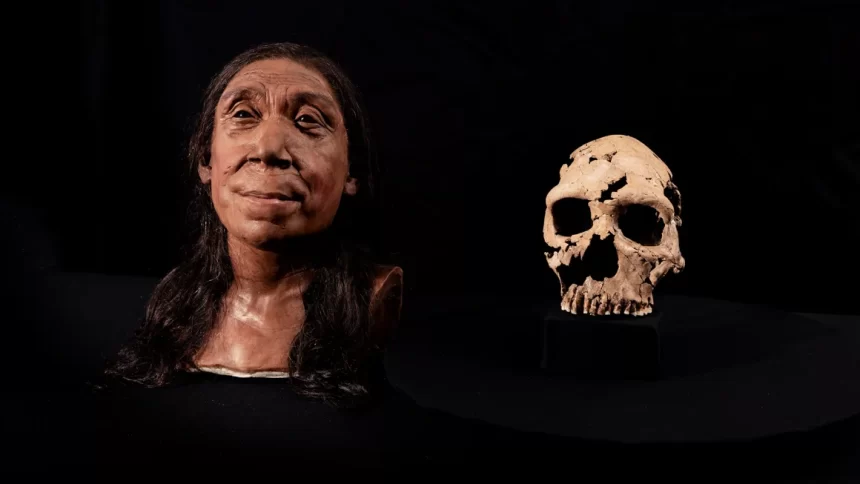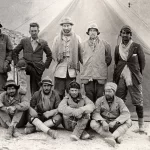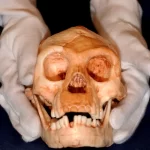A 40-something woman was buried in a cave 75,000 years ago, laid to rest in a gully hollowed out to accommodate her body. Her left hand was curled under her head, and a rock behind her head may have been placed as a cushion.
Known as Shanidar Z, after the cave in Iraqi Kurdistan where she was found in 2018, the woman was a Neanderthal, a type of ancient human that disappeared around 40,000 years ago.
Scientists studying her remains have painstakingly pieced together her skull from 200 bone fragments, a process that took nine months. They used the contours of the face and skull to guide a reconstruction to understand what she may have looked like.
The striking recreation is featured in a new documentary “Secrets of the Neanderthals” produced by BBC for Netflix, which is available for streaming on Thursday.
With pronounced brow ridges and no chins, the skulls of Neanderthals look different from those of our own species, Homo sapiens, said Dr. Emma Pomeroy, a paleoanthropologist and associate professor with the University of Cambridge’s department of archaeology who unearthed the skeleton and appears in the new film. The Shanidar Z facial reconstruction suggests that these differences might not have been so stark in life, Pomeroy said.
“There is some artistic license there, but at the heart of it is the real skull and real data on what we know about (these) people,” she said.
“She’s actually got quite a large face for her size,” Pomeroy added. “She’s got quite big brow ridges, which typically we wouldn’t see, but I think dressed in modern clothes you probably wouldn’t look twice.”
New analysis
When Pomeroy first excavated the skeleton, its sex wasn’t immediately obvious because only the upper half of the body was preserved. It lacked telltale pelvic bones. The team that initially studied the remains relied on a relatively new technique involving the sequencing of proteins inside tooth enamel to determine Shanidar Z’s sex, which is revealed for the first time in the documentary.
Those researchers from the universities of Cambridge and Liverpool estimated the specimen’s height to have been around 5 feet (1.5 meters) by comparing the length and diameter of her arm bones with data on modern humans. An analysis of wear and tear on teeth and bones suggested she was in her mid-40s at the time of her death.
“It’s a reasonable estimate, but we can’t be 100% sure, actually, that they weren’t older,” Pomeroy said. “What we can say is this is someone who had lived a relatively long life. For that society, they probably would have been quite important in terms of their knowledge, their life experience.”
The cave where Shanidar Z was buried is well-known among archaeologists because a Neanderthal grave discovered there in 1960 led researchers to believe that Neanderthals may have interred their dead with flowers — the first challenge to the prevailing view that the ancient humans were dumb and brutish. Subsequent research by Pomeroy’s team, however, has cast doubt on that flower burial theory.
Instead, they suspect the pollen discovered among the graves may have arrived via pollinating bees.
Still, over the years scientists have found increasing evidence of Neanderthals’ intelligence, sophistication and complexity, including art, string and tools.
Neanderthals repeatedly returned to Shanidar Cave to lay their dead to rest. The remains of 10 Neanderthals have been unearthed at the site, half of which appear to have been buried deliberately in succession, research has found.
Neanderthals may not have honored their dead with bouquets of flowers, but the inhabitants of Shanidar Cave were likely an empathetic species, research suggests. For example, one male Neanderthal buried there was deaf and had a paralyzed arm and head trauma that probably rendered him partially blind, yet he lived a long time, so he must have been cared for, according to research.
Shanidar Z is the first Neanderthal found in the cave in more than 50 years, Pomeroy said, but the site could still yield more discoveries. During the filming of the documentary in 2022, Pomeroy uncovered a left shoulder blade, some rib bones and a right hand belonging to another Neanderthal.
“I think our interpretation at the moment,” she said, “is that actually this is probably the remains of a single individual, which has then been disturbed.”
Reconstructing the skull
Pomeroy described reconstructing Shanidar Z’s skull, which had been crushed relatively soon after death as a “high-stakes 3D jigsaw puzzle.” The fossilized bones were hardened with a glue-like substance, removed in small blocks of cave sediment and wrapped in foil before researchers sent them to the University of Cambridge for analysis.
In the Cambridge lab, researchers took micro-CT scans of each block and used the scans to guide extraction of bone fragments. Pomeroy’s colleague Dr. Lucía López-Polín, an archaeological conservator from the Catalan Institute for Human Palaeoecology and Social Evolution in Spain, pieced over 200 bits of skull together by eye to return it to its original shape.
The team scanned and 3D-printed the rebuilt skull, which formed the basis of a reconstructed head created by Dutch paleoartists Adrie and Alfons Kennis, twin brothers who built up layers of fabricated muscle and skin to reveal Shanidar Z’s face.
Pomeroy said the reconstruction helped “bridge that gap between anatomy and 75,000 years of time.”










